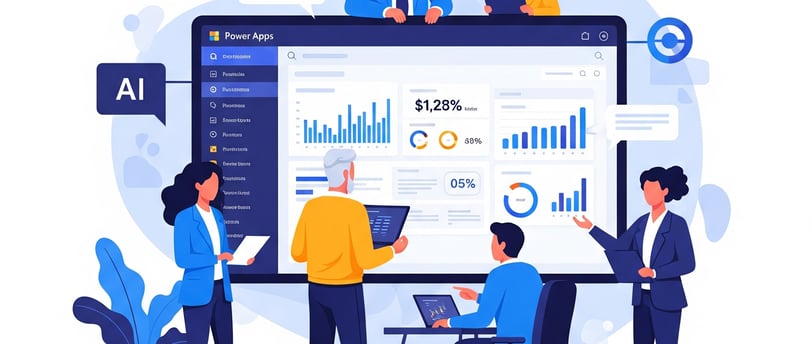The Future of Business Analysis in 2025: Embracing Power Apps and AI
In this blog post, we discuss The Future of Business Analysis in 2025: Embracing Power Apps and AI
Jamie Sables
6/6/20253 min read


The Future of Business Analysis in 2025: Embracing Power Apps and AI
Introduction
Business analysis is changing.
By 2025, your job as a business analyst will look very different. You will use tools like Microsoft Power Apps and AI every day.
These tools help you solve problems faster. They make it easier to work with data and build simple apps without coding.
If you still rely on spreadsheets and manual tasks, now is the time to adapt.
Let’s look at what’s ahead.
What Business Analysis Means in 2025
The role is more technical than before.
You will work with cloud platforms, automation tools and real-time dashboards.
Key tasks will include:
Analysing data to support quick decisions
Building simple apps to improve processes
Using AI to find trends and predict outcomes
Working with developers and product teams
You don’t need to be a coder. But you do need to be comfortable using digital tools.
Why Low-Code Platforms Matter
Low-code platforms help you build apps with little to no programming.
Power Apps is one of the most popular tools.
You can:
Drag and drop features to build an app
Connect to Excel, SharePoint or SQL
Create workflows with Power Automate
Share apps with teams in your organisation
This lets you fix problems without waiting for developers.
It saves time and helps teams move faster.
AI Tools You’ll Use Daily
AI is now part of business analysis.
Here’s how you might use it:
Use natural language tools to write summaries
Spot trends in large data sets
Get recommendations for the next best action
Automate data entry and reporting
For example, if you're reviewing sales data, AI can flag patterns you may miss.
You don’t need to understand how the model works. You just need to know how to apply the results.
Combining Power Apps, AI, and Power BI
You can connect Power Apps with Power BI and AI tools.
This means:
Build apps to collect new data
Use AI to analyse that data
Show the results in a Power BI dashboard
One client in retail used this setup to track in-store issues. Staff logged problems in a Power App. AI tagged them by category. Power BI then showed trends by store location.
You can apply the same idea in HR, logistics, or finance.
Skills You Should Focus On
Here’s what will help you stay relevant:
Learn the basics of Power Apps and Power Automate
Understand how to ask the right questions from data
Get comfortable using Power BI
Improve communication and writing skills
Work closely with product owners and developers
Soft skills matter. You’ll still need to listen, ask questions, and translate business needs.
Automation Is Now Standard
Manual tasks waste time.
Many companies now use Power Automate to:
Trigger alerts when key data changes
Move files across systems
Collect approvals through email or Teams
Schedule regular reports
This frees you to focus on more useful work.
Start small. Automate one task. Then build from there.
Working With Citizen Developers
Your colleagues in operations, sales or marketing may start building their own apps.
This is a good thing.
Your job is to support them.
You can:
Help them plan the logic
Guide data structure and naming
Review app performance and safety
This makes teams more independent and speeds up delivery.
How You Gather Requirements Will Change
Forget long documents and workshops.
Instead, you will:
Co-design apps with users in Power Apps
Test ideas in real time
Use AI tools to generate user stories
Record feedback directly in digital tools
You’ll still need to validate needs. But the process is more hands-on and collaborative.
Dashboards and Live Reports
Power BI dashboards will replace static reports.
You can build dashboards that:
Update in real-time
Track KPIs with colour indicators
Send alerts when something goes wrong
Let users filter by location, team or time
This helps decision-makers act faster.
AI Chatbots in Daily Work
Chatbots can now help analysts too.
Use them to:
Answer common user questions
Collect simple data
Walk users through new features
Trigger workflows based on responses
For example, an HR chatbot could guide managers through a performance review form.
You don’t need to build the bot from scratch. Use tools like Power Virtual Agents.
How to Stay Ahead
Business analysts who adapt will be in demand.
You can stay current by:
Taking online courses (e.g. Microsoft Learn, Coursera)
Joining local Power Platform user groups
Testing new tools in a safe environment
Asking your team what repetitive work they want to fix
Practice is the best way to learn.
FAQs
Do I need to learn how to code?
No. But knowing basic logic and formulas helps.
Is Power Apps only for Microsoft users?
It works best with Microsoft tools, but can connect to many external services.
How long does it take to learn Power Apps?
You can build your first simple app in a day. Full confidence takes a few weeks of use.
Can AI fully replace analysts?
No. AI supports your work, but it doesn’t replace your judgement or communication.
What’s the first thing I should automate?
Start with something small. For example, a weekly email report or a form approval process.
How do I show value as an analyst today?
Deliver small wins fast. Build trust by solving one real problem with data or automation.
Final Thoughts
Your role is changing.
You don’t need to become a developer. But you do need to build smart apps, use real-time data, and apply AI tools.
Power Apps and AI are not just tools. They are the new way of working.
If you start today, you’ll be ready for tomorrow.